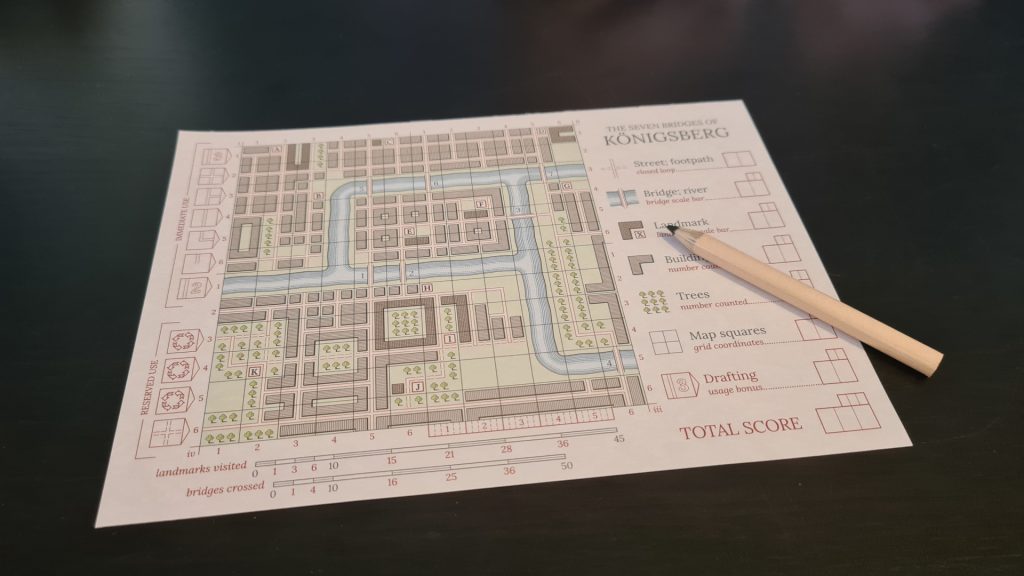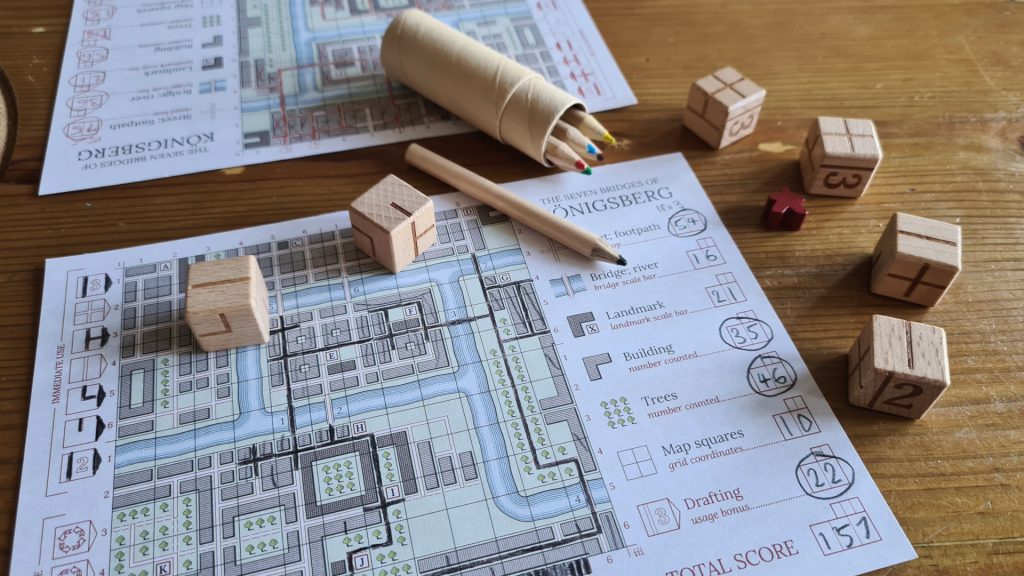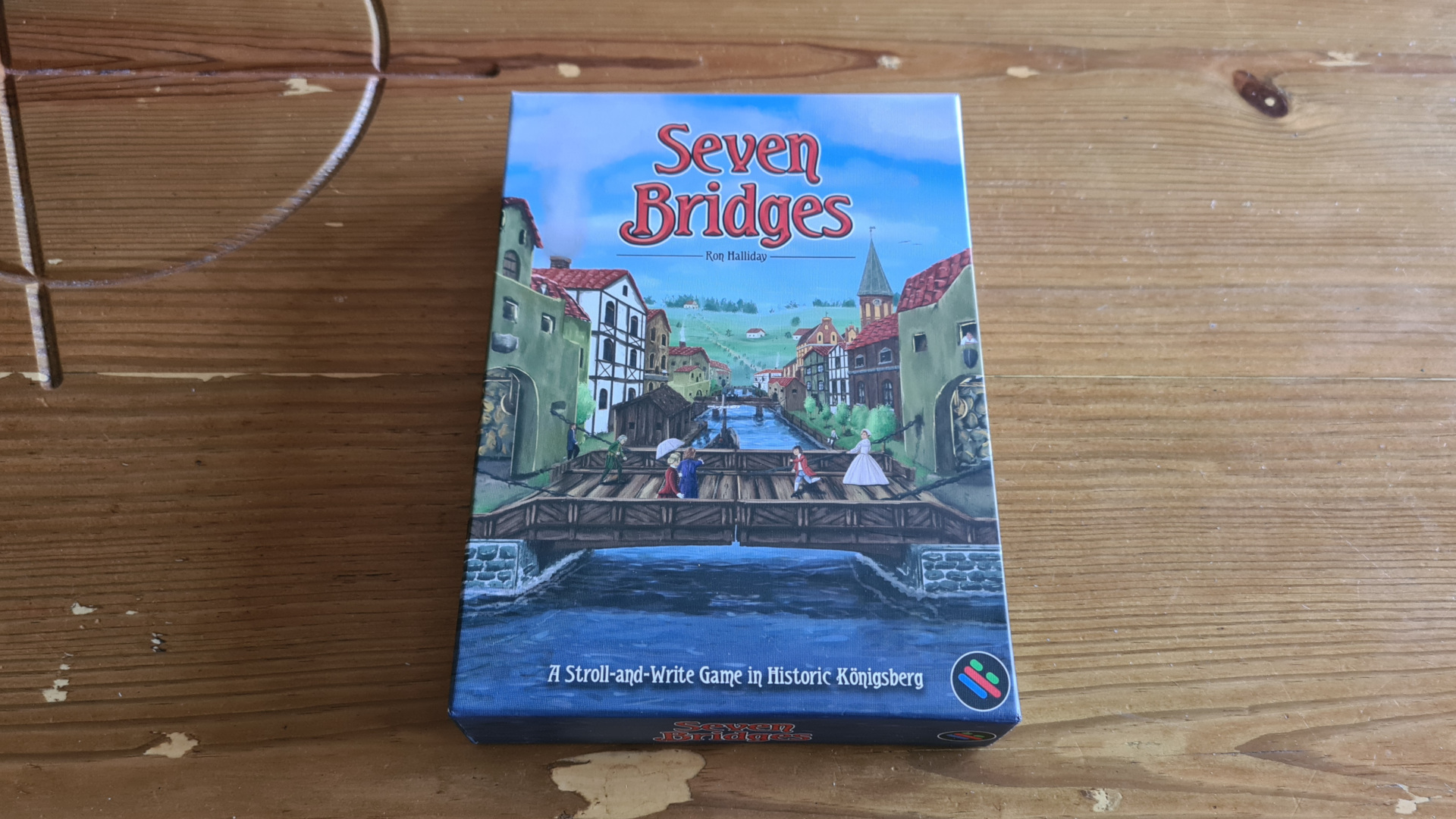Seven Bridges is a brand new dice drafting based roll and write board game from Puzzling Pixel Games. Designed by Ronald Halliday, the game sees 1 – 6 players exploring the streets of the European city of Königsberg, by drafting parts of routes. Lasting around 30 – 40 minutes, players will visit landmarks, wander across bridges and along paths flanked by trees. However, is this a city players will want to explore or is it as fun as the maths problem that the city started? Let’s find out!
Setup is as simple as passing everyone a map sheet and coloured pencil, choosing the starting player and passing them the first player marker and the dice, and communally deciding where on the map everyone will start. If players cannot decide together, they can roll the dice to help them determine what quadrant of the map and the coordinates for the starting space. The roads and potentially footpaths on the starting space are coloured in and the game is ready to begin.
Played out across 5 rounds, Seven Bridges sees players utilize 30 dice in total to draw lines onto their map. Depending on the player count not everyone will get the same number of dice within a round but overall it all balances out. On a turn the active player rolls the dice, with drafting then commencing. Going clockwise around the table, starting with the active player, each claims a die until all are taken. The players will be drawing the lines indicated by the dice they draft in order of taking them.
When drawing new lines there are a range of restrictions to follow. Lines must connect to the network already drawn by the player, with at least one point of the new lines connecting. Apart from 2 special die faces, all new lines can only be added to one space. Lines can be drawn on spaces that have already been used, but only if they do not draw over previous parts of your network. The map also features some footpaths and these cannot be utilized until the footpath bonus is unlocked. At times due to these rules it can be impossible for a specific dice to be used. The player can in this moment “downgrade” the die face until they reach a face they can draw.

Players are always able to use the 2 “Get on your horse” faces, as they break the mould. These faces show a 2 or 3 straight and can cross over multiple spaces. Players cannot draw these perpendicular from their network. Still, choosing any end point they can decide to draw a straight line up to the indicated value. For example, for the 2 straight this can be a full 2 squares, 1.5 squares, 1 square or half a square distance.
Players are growing their network to visit landmarks, cross bridges and see the city. With 11 different landmarks to potentially see, drawing your network past the landmark letters on the map trigger bonuses. There are 6 instant use bonuses, 1 for each of the die faces, and 4 reserved use bonuses. The instant bonuses, as their name suggests, sees the chosen die face drawn instantly onto their network by the player, with the bonus shaded in. This means it cannot be chosen again later and that it’ll score the player points. The reserved use options are half shaded to indicate they can be used by the player but are only fully shaded when activated. Three of these allow the player to re-roll the dice or distribute the already rolled dice. The final reserved use unlocks the use of footpaths for the player.
At the end of Seven Bridges players will calculate the points of 7 different scoring categories, though there is a twist. Players will score their biggest closed loop in their network, by multiplying the number of corners a loop has by the number of bridges the loop crosses. Points are also scored for bridges crossed, landmarks visited, trees walked past and standard buildings seen. With some route reaching the edge of the map, points are awarded for the map coordinates drawn to. For each bonus actually used from landmarks points are gained. Players don’t always score all of these though. Each player can score as many categories as bridges they have crossed, with whomever has scored most winning.
Scoring isn’t an overly quick endeavour – despite the bridges and landmarks visited being tracked during the game. On top of a fair chunk of maths, players will also potentially be counting the 50+ buildings they’ve passed by and many many trees. The way the objectives work makes complete sense but that doesn’t make it any quicker – plus it’s not really advantageous to try to count most whilst playing.

It shouldn’t be a surprise in a game called Seven Bridges but going for the bridges is key to scoring high. Not only do they signify how many of the objectives you can score, they are also one of the objectives and key to scoring big in the footpath objective too. Players will easily cross a few bridges whilst trying to do other objectives, though the emphasis on them does stop players from truly varying their routes to victory. You can still go for a huge footpath closed loop, or see countless buildings. More often than not though it is better to make sure that an extra bridge is crossed as part of it.
The map sheets are well designed. Offering many routes and streets for players to wander along, the city of Königsberg offers a lot of choices. Around the map though there are some brilliant touches. The map squares scoring objective is made to look like grid coordinates, and the bridge and landmark trackers are akin to the distance measurements often found at the bottom of a map. The standout and underrated feature is the round counter. If it wasn’t for the round counter in the first couple of games we’d have lost where in the round we were up to multiple times. On top of this it is an effective way to pause and save the game for later. It might be initially overlooked but not for long!
A huge pad of maps is included and to make them last even longer each sheet is double sided. This has an additional benefit that you can scribble across one side while explaining the rules and scoring, before just flipping it over and playing the game. A range of colour pencils are included, coming in a neat storage tube. For the most part these work well, with the colour chosen just personal preference. Unfortunately, the yellow colour is hard to see in anything but good lighting. Still, 5 other colours are available. The final component is a red meeple. First player markers are often an underused but flamboyant component. The small meeple in Seven Bridges is not, being rather on the small side it can be easily missed when glancing around the table but gets the job done.
There is one rule that slightly sticks out, being unintuitive with the rest of the logical ruleset. As players can use a half road to turn say a T junction into a cross road it feels odd that a 2 or 3 straight cannot be utilized as a half road to turn a straight road into a T junction. For some reason the Get On Your Horse die faces must be used from the end of a route and not the middle. This seems like a restricting rule that just needs to be remembered without any logic behind it past being part of the puzzle. It’s far from impossible to remember when playing, if stressed during the teach. Still, it is an exception style rule that could trip some players up.
Seven Bridges brings the most out of the map, with choices of how to use every drafted dice. It shouldn’t be a surprise how much the game revolves around the bridges. Regardless, it would have been nice for what scoring categories aren’t scored to be randomised and not based on the bridges crossed, as this would have forced players to play that bit more differently each game. There are aspects that make the game feel different from one game to the next, such as the ability to start from almost any square of the map. Playing multiple games back to back, the experience slowly starts to feel a little samey, though with the theming it’s still pleasant to think of yourself wandering down the streets of Königsberg.
(Editor’s Note: Seven Bridges was provided to us by Asmodee for the review. The game is currently available from local board game stores! Find your local store here.)

